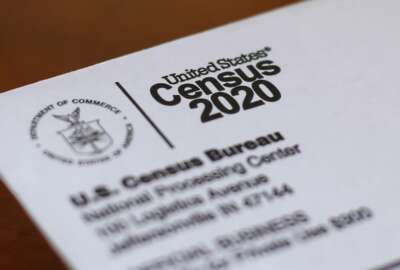
Census officials wary of ‘serious’ risks to data quality with compressed timeline
Stuck between delays from the coronavirus pandemic and the Trump administration’s instruction to still complete the count on time, the Census Bureau is working on...
Stuck between delays from the coronavirus pandemic and the Trump administration’s instruction to still complete the count on time, the Census Bureau is working on a compressed timeline to wrap up field operations and process the data.
Senior bureau officials told the House Oversight and Reform Committee in closed-door briefings late last month that the bureau has revised its schedule to meet statutory deadlines.
But documents released by the committee show bureau officials have expressed concerns about what some expedited steps will mean for the accuracy of the final data.
In a slideshow presentation from Aug. 3, Census officials warned that a compressed review period for the decennial data “creates risk for serious errors not being discovered in the data – thereby significantly decreasing data quality.”
If serious errors are discovered in the data, those officials said they may not be fixed, due to lack of time to research and understand the root cause or to re-run and re-review multiple state files.
While Congress has demonstrated bipartisan support for extending statutory deadlines for the 2020 count, it has yet to pass legislation that would allow those changes. Absent that legislation, top officials at the Commerce Department have instructed the bureau to find a way to deliver the apportionment data by Dec. 31.
Census officials have already said they are “past the window” of delivering the apportionment data on time, and committee chairwoman Carolyn Maloney (D-N.Y.) said lawmakers should make extending the deadlines a priority.
Read more: Management news
“The new information obtained by the Oversight Committee makes clear that Congress must act now to fulfill our responsibility under the Constitution to help ensure an accurate and complete count for the 2020 Census,” Maloney wrote in a letter to House and Senate leadership.
Deputy Director Ron Jarmin told the committee late last month that bureau officials crunched the decennial schedule as much as possible, and found that if the bureau could wrap up field operations by Sept. 30, the bureau would have a “feasible critical path” to meet the statutory deadline.
That plan would give enumerators one less month to knock on doors than the bureau originally planned, but would give the bureau two-and-a-half months to process the 2020 census data on the back end.
“We’re essentially running the same things that we were planning to do. We’re just doing them faster,” Jarmin said.
Associate Director for Decennial Programs Al Fontenot told the committee that in addition to compressing the schedule into a shorter time period, the bureau had to scale back a random re-review of households during non-response follow-up and cancel a second data review with state demographers.
Despite the pressure to meet deadlines, Associate Director for Field Operations Tim Olson said the bureau was more than nine points ahead of where officials expected to be at this point in non-response follow-up (NRFU). As of Sept. 1, more than 60% of the NRFU workload has been completed nationwide.
“Barring any catastrophes … we can get done,” Olson said.
But this being 2020, catastrophes remain a perennial concern. The bureau will carry out the rest of its field operations during hurricane season on the East Coast, while wildfires have caused significant disruption for the West Coast.
Read more: Agency oversight news
Jarmin said a spike in COVID cases in an area could also make some households wary of conducting an interview with a census enumerator.
“Not only is it not advisable to do a Census during a pandemic, it’s not advisable to do a Census during hurricane season. The rest of the data collection is still going to be during hurricane season, and that could really be something that throws a wrench in the works for us,” he said.
Olson said natural disasters or an especially bad hurricane season are out of the bureau’s ability to plan around, which could further stress its compressed schedule.
“Is Hurricane Laura going to come up and down the Gulf Coast or the Atlantic Coast? Those are things out of my control … That’s the risk all of us face. Can we get to done if that kind of thing occurs, and it occurs more than once? It doesn’t matter how many bodies I send in, or how much money we try to spend, we may not get there by Sept. 30, just because of conditions out of everybody’s control. That’s what keeps me up at night,” Olson said.
Idaho, West Virginia, Washington, Kansas and Oregon have the highest rate of enumeration so far — each state is more than 90% complete — but many other states still have some catching up to do, with less than a month of fieldwork left.
“In my world, if I’ve got a state that’s in the 80% complete, and let’s say it’s the middle of September, I’m sweating bullets. At that point, if I’m at 85[% ]or 90[%], I’m fine,” Olson said, “Probably 80% — that’s a lot to overcome. Now you can bet that we’ll be moving people around. We might be changing management teams. We’ll do all the things that we normally do when we’re behind in an area.”
The bureau now updates its website daily with self-response rates and the total percentage of addresses that have been counted in each state.
Jarmin told the committee that Deputy Commerce Secretary Karen Dunn Kelley had instructed the bureau to create a new plan in late July to deliver the apportionment count without any statutory extension. Kelly asked for the plan to be presented to Secretary Wilbur Ross at an Aug. 3 meeting.
However, Maloney said Commerce Department officials prevented Jarmin from elaborating on some of the risks of running some operations “concurrently rather than sequentially,” and prevented Fontenot from discussing some of the risks that come from cutting data processing short by 60 days.
The Government Accountability Office, in a report last week, warned that IT systems and operational testing was more than three months behind schedule, and that “there will be less time available to complete the remaining system integration testing and operational testing needed before the response processing operation begins.”
Copyright © 2025 Federal News Network. All rights reserved. This website is not intended for users located within the European Economic Area.
Jory Heckman is a reporter at Federal News Network covering U.S. Postal Service, IRS, big data and technology issues.
Follow @jheckmanWFED





